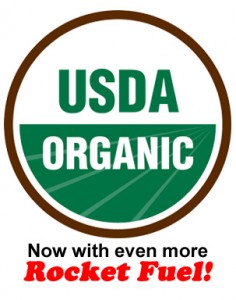Did you know that Perchlorate can now be found in virtually every human tested?
Perchlorates are salts derived from Perchloric Acid, which is widely used in Rocket Fuel and the Pyrotechnics Industry.

So what’s bad about having Perchlorate in your body?
This is a serious concern because Perchlorate is an endocrine-disrupting chemical known to disrupt thyroid function and hormone production by inhibiting your thyroid gland’s iodine uptake. Perchlorate has also been shown to affect brain development and growth of fetuses, infants and children.
Unfortunately, most Perchlorate salts are highly water soluble, and we’re now experiencing widespread land and water contamination in many areas of the world.
Perchlorate Found in Organic Food
If you’re like most people, you buy organic food to avoid chemicals and contaminants.
If water contaminated with Perchlorate is used to irrigate crops, those vegetables will be tainted with high levels of this endocrine-disrupting chemical: whether certified organic or not.
A study on Perchlorate levels in North America reported that:
Results show that 16 percent of the conventionally produced samples and 32 percent of the organically produced samples had quantifiable levels of perchlorate … Estimated perchlorate exposure from organically produced leafy vegetables was approximately 2 times that of conventional produce … “
Unless something is done about the food production and distribution system, it is no longer possible to believe you can avoid toxins simply by eating organic.
Perchlorate Found in Infant Formula
In 2009, a government study found that 15 brands of powdered infant formula were contaminated with Perchlorate, a toxic compound in rocket fuel.
The two most contaminated brands, made from cow’s milk, accounted for 87% of the U.S. powdered formula market in 2000. Although the scientists did not identify the formula brands they tested, it was later reported that they were referring to Similac and Enfamil — two brands that dominate every supermarket in the United States.
Most people are exposed to Perchlorate through their diet in the form of contaminated water and/or foods. But infant exposure may be far greater than that of adults, especially if they are fed infant formula, as the toxin may be present in both the formula and/or the water used to prepare it.
According to the Environmental Working Group:
Perchlorate Found in Drinking Water
Perchlorate Data from the U.S. Environmental Protection Agency (EPA) shows that:
This contamination exists not only in drinking water but also in water used to irrigate crops. Water from the Colorado River is notorious for being contaminated with low levels of Perchlorate from aerospace and defense-related industries and it’s known that lettuce irrigated with Colorado River water is contaminated with Perchlorate.
What Water Treatment Systems Reduce Perchlorate?
Current research shows that Perchlorate does not absorb well through the skin.
Based on potential exposure, the most cost effective measure to take would be a drinking water system capable of reducing Perchlorate.
Drinking Water Purification
Carbon filters like those found in refrigerators and water pitchers have ZERO effect on removing Perchlorate.
A small under sink Reverse Osmosis (RO) system would be a cost effective treatment method for clean drinking water. For as little as $0.05 a gallon, you could have clean water and clear ice cubes.
Summary
In February, 2011 the EPA reversed its previous ruling, and set an enforceable limit on Perchlorate in drinking water. With Perchlorate showing up in places like organic food and baby formula, drinking Perchlorate-free water is one way you can limit your exposure.
If you would like to see what your options are for better water, sign up for a FREE WATER TEST. Upon testing your water, a specialist can review your options and technologies available to help you.

